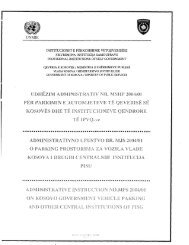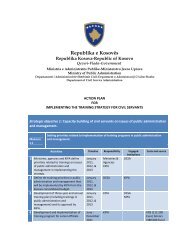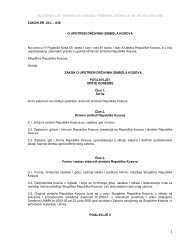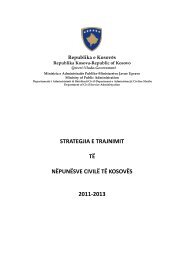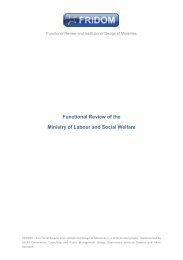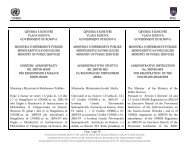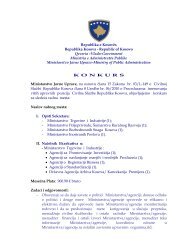Functional Review of the Ministry of Environment and Spatial Planning
Functional Review of the Ministry of Environment and Spatial Planning
Functional Review of the Ministry of Environment and Spatial Planning
Create successful ePaper yourself
Turn your PDF publications into a flip-book with our unique Google optimized e-Paper software.
II.5 Co-ordination function<br />
Inter-administrative coordination <strong>and</strong> interaction is essential for an effective, efficient <strong>and</strong> smooth<br />
functioning <strong>of</strong> <strong>the</strong> public administration. It critically depends on <strong>the</strong> readiness to communicate in a proactive<br />
way. For <strong>the</strong> environmental sector administration both horizontal <strong>and</strong> vertical coordination are <strong>of</strong><br />
vital importance.<br />
Examples <strong>of</strong> particular areas to improve coordination include transport (management <strong>of</strong> air quality in<br />
relation to transport); agriculture (obligation under <strong>the</strong> new Common Agricultural Policy in <strong>the</strong> EU to take in<br />
consideration <strong>of</strong> environmental sustainability in farming); <strong>and</strong> energy (introduction <strong>of</strong> renewable energy<br />
sources that contribute significantly to environmental quality<strong>and</strong> has a high priority in <strong>the</strong> EU). Apart from<br />
ad hoc consultations, such a mechanism does not exist yet in Kosovo.<br />
Recommendation II.8: Designate <strong>and</strong> fully operate <strong>the</strong> Advisory Board for Protection <strong>of</strong> <strong>Environment</strong> in<br />
Government as an <strong>of</strong>ficial decision-facilitating inter-ministerial body. The goal <strong>of</strong> inter-ministerial<br />
coordination is to integrate <strong>the</strong> environmental considerations into <strong>the</strong> agriculture, industry, transport <strong>and</strong><br />
energy sectors to achieve environmental sustainability.<br />
II.6 International cooperation function<br />
Good management requires a national strategy for international environmental cooperation, setting <strong>of</strong><br />
priorities in view <strong>of</strong> <strong>the</strong> obligations, <strong>the</strong> estimation <strong>of</strong> <strong>the</strong> expected costs <strong>of</strong> implementation through <strong>the</strong> years,<br />
a cost-benefit analysis prior to entering <strong>the</strong> international obligation, clarification <strong>of</strong> internal institutional<br />
responsibilities, <strong>and</strong> due reporting to <strong>the</strong> decision-making <strong>and</strong> supervisory state <strong>and</strong> entity bodies.<br />
Kosovo is nei<strong>the</strong>r a direct signatory <strong>of</strong> any environmental Conventions or Protocols nor up to date ratified<br />
any <strong>of</strong> <strong>the</strong>m.<br />
Recommendation II.9: Develop Kosovo’s national strategy for international co-operation; commencing <strong>the</strong><br />
active co-operation with <strong>the</strong> European <strong>Environment</strong> Agency (EEA) through regular transmission <strong>of</strong><br />
environmental data to EIONET (European <strong>Environment</strong> Information <strong>and</strong> Observation Network). Similar<br />
activities should be undertaken in spatial planning through active participation in ESPON (European <strong>Spatial</strong><br />
<strong>Planning</strong> Observation Network) <strong>and</strong> taking <strong>the</strong> advantage to develop <strong>the</strong> international project from EURICUR<br />
(European Institute for Comparative Urban Research). KEPA <strong>and</strong> Institute for <strong>Spatial</strong> <strong>Planning</strong> should be<br />
appointed as <strong>the</strong> focal points in Kosovo.<br />
II.7 Human Resources<br />
The Personnel Office seems to have sufficient capacity including a special coordinator for HR development <strong>and</strong><br />
an annual HR development plan, but line managers indicate that responsiveness to <strong>the</strong>ir needs or a strategic<br />
approach are both very limited. The expectations <strong>of</strong> <strong>the</strong> senior ministry management towards <strong>the</strong> Personnel<br />
Office would need to change as well, moving towards a more strategic approach in assessing <strong>the</strong> <strong>Ministry</strong> HR<br />
needs <strong>and</strong> filling <strong>the</strong> gaps through a combination <strong>of</strong> recruitment <strong>and</strong> existing staff development.<br />
The current set <strong>of</strong> skills appears broadly adequate for <strong>the</strong> current set <strong>of</strong> functions but is weak on <strong>the</strong><br />
policy-making side. If <strong>the</strong> <strong>Ministry</strong>’s policy side is streng<strong>the</strong>ned <strong>the</strong>n a real skills gap will emerge.<br />
Looking at human resources two elements become apparent:<br />
<strong>the</strong> relatively high number <strong>of</strong> directors <strong>and</strong> heads <strong>of</strong> sectors compared to more junior staff – resulting<br />
in an inverted pyramid effect;<br />
<strong>the</strong> significant gap between <strong>the</strong> number <strong>of</strong> posts established (297) <strong>and</strong> <strong>the</strong> number <strong>of</strong> posts actually<br />
filled (281). For <strong>the</strong> time being it is underst<strong>and</strong>able that <strong>the</strong>re is a vacant position in nuclear radiation<br />
<strong>and</strong> noise but o<strong>the</strong>r vacant positions at <strong>the</strong> environmental departments significantly reduce <strong>the</strong><br />
performance capacity <strong>of</strong> <strong>the</strong> whole ministry.<br />
The first element is typical for underdeveloped administrations who are also understaffed (an important<br />
factor in this is <strong>the</strong> current rigid salary system). The second phenomenon is simply a lack <strong>of</strong> finances.<br />
17



